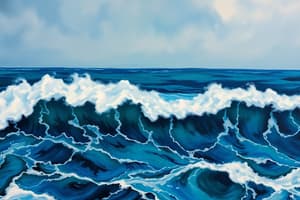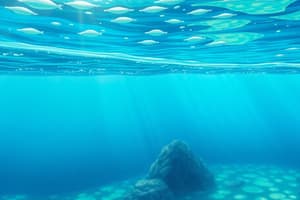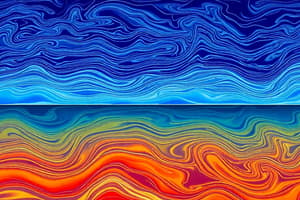Podcast
Questions and Answers
How does the depth of the thermocline typically vary between tropical and higher latitude regions?
How does the depth of the thermocline typically vary between tropical and higher latitude regions?
- The thermocline is deeper at higher latitudes due to increased mixing from storms.
- The thermocline is shallower in the tropics due to less solar heating.
- The thermocline depth is consistent across all latitudes, but the temperature gradient is steeper in the tropics.
- The thermocline is deeper in the tropics because the ocean is heated to a greater depth. (correct)
What oceanic condition is indicated where precipitation exceeds evaporation?
What oceanic condition is indicated where precipitation exceeds evaporation?
- Increased temperature
- Lower salinity (correct)
- A more intense thermocline
- Increased density due to higher salt concentration
What is the pycnocline primarily affected by when the thermocline and halocline coincide?
What is the pycnocline primarily affected by when the thermocline and halocline coincide?
- A pronounced density gradient (correct)
- A moderate density gradient
- A subtle change in temperature
- Minimal impact to density structure
Which of the following is the MOST accurate description of the water found below the thermocline?
Which of the following is the MOST accurate description of the water found below the thermocline?
What is the halocline?
What is the halocline?
Flashcards
Thermocline
Thermocline
The ocean layer where temperature changes rapidly with depth.
Halocline
Halocline
A zone of rapid salinity increase with depth in the ocean.
Pycnocline
Pycnocline
A layer in the ocean where density increases rapidly with depth.
Salinity Impact
Salinity Impact
Signup and view all the flashcards
Tropical Thermocline
Tropical Thermocline
Signup and view all the flashcards
Study Notes
- The thermocline is the middle ocean layer where temperature changes rapidly as depth increases.
- Decreasing temperature is a major factor in forming the pycnocline.
- Low salinity occurs where precipitation is greater than evaporation.
- The halocline is a zone characterized by a rapid increase in salinity with depth.
- The halocline often aligns with the thermocline, creating a distinct pycnocline.
- The tropical thermocline is deeper because the ocean is heated to a greater depth in the tropics.
- The transition to colder, denser water is more abrupt in the tropics compared to higher latitudes.
- Thermocline depth and intensity are affected by latitude, season, local conditions, currents, and other factors.
- Water below the thermocline is very cold, with temperatures ranging from -1°C to 3°C.
Studying That Suits You
Use AI to generate personalized quizzes and flashcards to suit your learning preferences.





